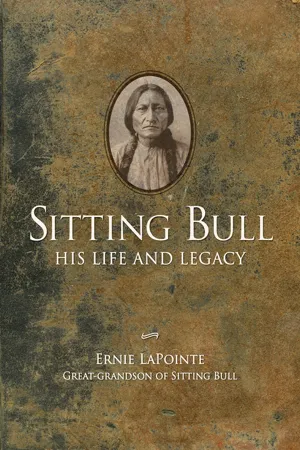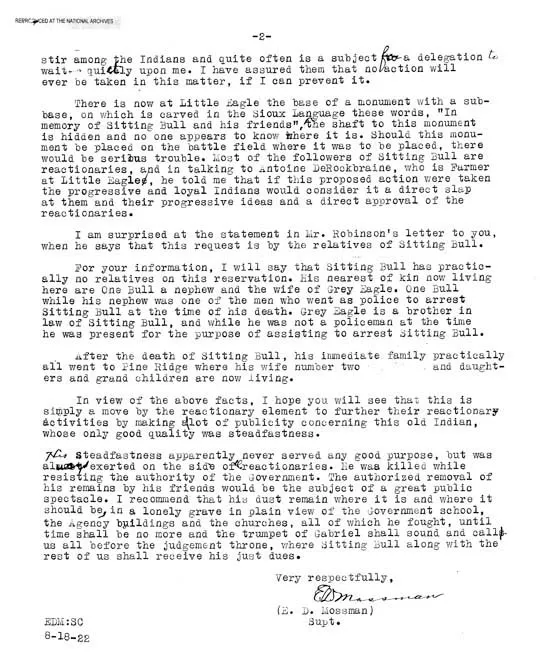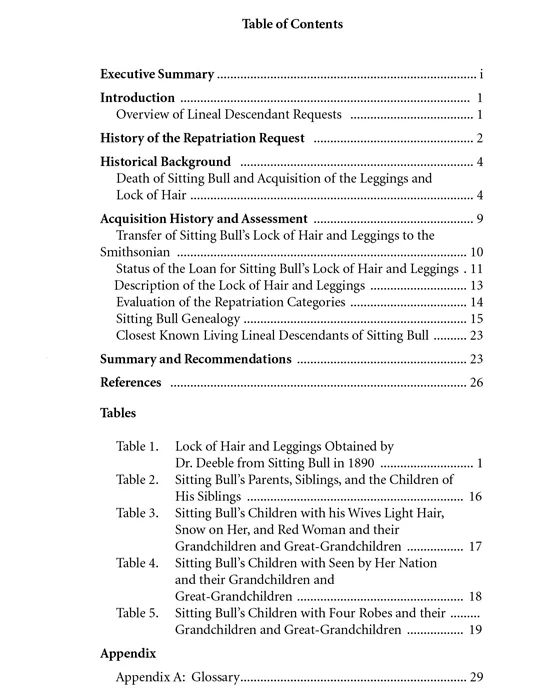![]()
A Letter from E. D. Mossman, Superintendant of the Standing Rock Indian School, to the
Commissioner of Indian Affairs in Washington D.C.
![]()
A partial copy of the repatriation document regarding a lock of hair and leggings belonging to Sitting Bull. To view the entire document, please visit the following website:
http://anthropology.si.edu/repatriation/projects/index.htm
Assessment of a Lock of Hair and Leggings Attributed to Sitting Bull, a Hunkpapa Sioux, in the National Museum of Natural History, Smithsonian Institution
| William T. Billeck and Betsy Bruemmer |
| 2007 |
| Repatriation Office |
| Department of Anthropology |
| National Museum of Natural History |
| Smithsonian Institution |
Executive Summary
In compliance with the National Museum of the American Indian (NMAI) Act of 1989, 20 U.S.C. Section 80q (P.L. 101-185) as amended in 1996 (P.L. 104-278), this report provides an assessment of a lock of hair and leggings attributed to Sitting Bull, a Hunkpapa Sioux, in the collections of the National Museum of Natural History, Smithsonian Institution (Table 1). The lock of hair and leggings were obtained as a loan from Dr. Horace Deeble in 1896. Archival evidence indicates the items were acquired from Sitting Bull’s body by Dr. Deeble, an Army Surgeon at Fort Yates in 1890. In 1999, the National Museum of Natural History informed all federally recognized Sioux tribes that a lock of hair and the leggings of Sitting Bull were on loan to the National Museum of Natural History to initiate consultation with the tribes on the items. In 2001, Don Tenoso submitted a request for the repatriation of the lock of hair and leggings. Don Tenoso is a lineal descendant of One Bull, whom he identified as both the nephew and the adopted son of Sitting Bull. In 2002, all of the Sioux tribes were notified of the repatriation request from Don Tenoso and were asked for assistance in locating additional descendants of Sitting Bull. At the same time, three individuals who had been identified as descendants were also notified of the repatriation request. Ernie LaPointe submitted a repatriation request in 2002 along with documentation that there were four living great-grandchildren of Sitting Bull: Ernie LaPointe, Marlene Little Spotted Horse-Anderson, Ethel Little Spotted Horse-Bates, and Lorene Lydia Little Spotted Horse-Red Paint. Marlene Little Spotted Horse-Anderson submitted a power of attorney document allowing Ernie LaPointe to represent her on issues pertaining to Sitting Bull. Ernie LaPointe stated that according to family oral tradition, One Bull was the nephew of Sitting Bull and had not been adopted as Sitting Bull’s son, and he would not consider a joint repatriation with the descendants of One Bull. In 2006, Don Tenoso withdrew his repatriation request for the Sitting Bull items because he did not want the separate requests to divide the families.
Table 1. Lock of Hair and Leggings Obtained by Dr. Deeble from Sitting Bull in 1890.
Lineal descendants have the highest standing for making disposition decisions for repatriation under NAGPRA and under the Guidelines and Procedures for Repatriation of the National Museum of Natural History (2006) for the NMAI Act. When lineal descendants can be identified, the closest living generation of descendants has the highest standing and the first priority in making disposition decisions.
The lock of hair and leggings of Sitting Bull were loaned to the museum in 1896. The authority of Dr. Deeble, as a U.S. Army Surgeon, to acquire the lock of hair and leggings is evaluated in this report in order to determine whether the National Museum of Natural History can consider the lock of hair and the leggings to be part of the museum collections. Under U.S. Army regulations in effect at the time, Dr. Deeble, did not have the legal authority to acquire personal items from Sitting Bull’s body while employed as an Army Surgeon. In a 2003 letter, Lieutenant Colonel John Patrick of the Office of the Judge Advocate General stated that the Department of the Army had no legal interest in Sitting Bull’s lock of hair and leggings. Since Dr. Deeble did not have the legal right to acquire these items and the Department of the Army has no legal interest in the items, the National Museum of Natural History has sufficient possession and control of the lock of hair and leggings to consider a repatriation request. The lock of hair falls under the category of human remains under the NMAI Act and it is recommended that the lock of hair be offered for repatriation to the lineal descendants of Sitting Bull. The leggings do not fall into any of the four categories of items eligible for repatriation under the NMAI Act: human remains, funerary objects, sacred objects and objects of cultural patrimony. However, Dr. Deeble, the collector of the leggings, did not have the legal right to acquire them from Sitting Bull as personal property because they were not obtained with the permission of Sitting Bull or his family at the time that they were acquired. Under long-standing Smithsonian policy, items acquired under circumstances that cast doubt on the validity of the Smithsonian’s ownership or possession may be returned to a proper claimant. It is recommended that the leggings be offered for return to lineal descendants of Sitting Bull.
It is recommended that the lock of hair and the leggings be offered for return to the closest living lineal descendants who have requested these items: Sitting Bull’s great-grandchildren, Ernie LaPointe and Marlene Little Spotted Horse-Anderson. Ethel Little Spotted Horse-Bates and Lorene Lydia Little Spotted Horse-Red Paint, great-grandchildren of Sitting Bull who have not submitted a repatriation request, will be notified of this decision. In order for the museum to proceed with the return, all individuals of equal standing as closest descendants who have submitted a request for the lock of hair and leggings must be in agreement on the disposition of the items. Don Tenoso and all of the Sioux tribes will also be notified of this recommendation and will be sent a copy of this report. Individuals who have equal or greater standing based on lineal descendance or traditional kinship than the identified great-grandchildren of Sitting Bull should contact William Billeck at the Repatriation Office and provide evidence of their relationship to Sitting Bull if they wish to participate in the disposition decisions. Any new evidence that establishes that a descendant individual has equal or greater standing than the great-grandchildren will be considered by the museum and the evidence may alter the recommendations of this report. Thirty days prior to the return of the lock of hair and leggings, newspaper notices will be placed in regional newspapers to provide public notice to the descendants and to the Sioux people.
I. Introduction
This report presents the findings and recommendations for a repatriation request from the descendants of Sitting Bull for a lock of hair and cloth leggings that were obtained from Sitting Bull’s body shortly after his death. The request is being considered under the repatriation provisions of the NMAI Act of 1989, 20 U.S.C. § 80q (P.L. 101-185), as amended in 1996 (P.L. 104-278), and under the collection policy of the Smithsonian. The NMAI Act requires the Smithsonian Institution to inventory and identify the tribal origins of all Native American human remains currently in its possession. Culturally identifiable human remains are to be expeditiously returned to the culturally affiliated federally recognized tribe or lineal descendant upon their request. In compliance with this law, the Repatriation Office prepared this report to evaluate and document the affiliation of the lock of hair. The leggings, as described in the following report, do not fit the repatriation object categories of funerary object, sacred object, or object of cultural patrimony and have been evaluated under the Smithsonian collection policy.
The findings of this report are based on the National Museum of Natural History’s master computer catalog, correspondence sent to the museum by the original collectors, Department of Anthropology ledger books, catalog card files, original accession documents, reports, historical documents, publications, military records, and information provided by descendants of Sitting Bull.
The report is divided into five sections. Following the introduction, Section II presents an overview of the history of the repatriation request. Section III reviews how the lock of hair and leggings were obtained and loaned to the Smithsonian and describes the items. Section IV assesses the status of the lock of hair and leggings as a loan, evaluates the repatriation categories for the lock of hair and leggings, reviews the evidence that has been assembled on descendants of Sitting Bull, and identifies the closest living Sitting Bull descendants that are known to the museum. The final part, Section V, summarizes the findings of this report and provides recommendations.
Overview of Lineal Descendant Requests
Under the NMAI Act and the NAGPRA, lineal descendants, federally recognized tribes and Native Hawaiian organizations have the right to make repatriation requests for human remains and certain categories of objects. Lineal descendants are given the highest standing for making disposition decisions for repatriation of human remains and certain categories of objects under NAGPRA and under the Guidelines and Procedures for Repatriation of the National Museum of Natural History (2006). When lineal descendants can be identified, they have the sole responsibility for making disposition decisions and their decisions take precedence over the decisions of more remote descendants. When lineal descendants cannot be identified, the affiliated federally recognized tribe(s) or Native Hawaiian organization has the responsibility for making disposition decisions.
When lineal descendants can be identified, and objects or human remains have been found to fit a repatriation category, the closest living generation of descendants that have submitted a request have the highest standing and the first priority for making disposition decisions. All of the individuals within a generation of descendants have equal standing. For instance, all grandchildren that make a request have equal standing and that standing supercedes that of great-grandchildren. In this case, only the grandchildren would make disposition decisions and the great-grandchildren would have no role in the decisions unless the descendants with standing determined that they should be included in the disposition decisions. In order for a repatriation to proceed, all individuals that have made a request and have equal standing must agree on the disposition of the remains and/or objects. Known descendants who have not made a request and are of equal standing to those who have made a request will be notified by the museum of the intention to return the remains and/or objects and provided an opportunity to submit a request.
II. History of the Repatriation Request
In August of 1999, Chuck Smythe of the National Museum of Natural History Repatriation Office wrote to the representatives of the Sioux tribes to inform them that the museum held leggings and a lock of hair attributed to Sitting Bull. The following tribes were informed: Standing Rock Sioux Tribe, Oglala Sioux Tribe, Rosebud Sioux Tribe, Lower Brule Sioux, Crow Creek Sioux, Cheyenne River Sioux, Yankton Sioux Tribe, Flandreau Santee Sioux Tribe, Ft. Peck Sioux Tribe, Upper Sioux Indian Community, Shakopee Mdewakanton Sioux Community, Prairie Island Indian Community, Lower Sioux Indian Community, Santee Sioux Tribe, Spirit Lake Nation, and the Sisseton Wahpeton Sioux. Smythe explained that these items were not included in the ethnographic summary reports sent out in 1996 because the items were on loan to the museum. As it appears that the items were acquired without permission from the family of Sitting Bull, the Repatriation Office wished to consult with the Sioux tribes. Chuck Smythe left the Repatriation Office at the end of 2000, and William Billeck was assigned the responsibility to respond to inquiries on the Sitting Bull items.
The only response to the notification came on February 24, 2001, when Don Tenoso submitted a request for the repatriation of Sitting Bull’s lock of hair and leggings. He identified Henry Oscar One Bull as the son of Sitting Bull’s sister and as the adopted son of Sitting Bull through Hunka, the making of relatives. During a visit with William Billeck on February 26, 2001, Don Tenoso identified himself as the great-grandson of Henry Oscar One Bull and through adoption, as the great-great-grandson of Sitting Bull. One Bull was Sitting Bull’s nephew (sister’s son) and was not a biological lineal descendant. Don Tenoso wrote that:
...One Bull is the ‘son’ of Sitting Bull. The term ‘son’ is used to define the relationship between One Bull and Sitting Bull, because Sitting Bull ‘adopted’ (a modern US term), ‘Hunka’ (Lakota term meaning the making of relative) One Bull at a very early age from Sitting Bull’s sister [Don Tenoso to William Billeck, letter, February 24, 2001, italics added].
On April 24, 2001, William Billeck informed Don Tenoso that the museum would assemble a list of close descendants of Sitting Bull to notify of the request. Don Tenoso was asked to submit the names of any descendants that he thought should be notified of the request. The museum also would notify all of the Sioux tribes that a request for repatriation had been received. On November 29, 2001, Ron Little Owl, then a member of the Smithsonian’s Native American Repatriation Review Committee and a member of the Three Affiliated Tribes of North Dakota, told William Billeck that Ernie LaPointe, Ethel Little Spotted Horse-Bates, and Marlene Little Spotted Horse-Anderson were lineal descendants of Sitting Bull. On February 22, 2002, all of the federally recognized Sioux tribes and the three individuals reported to be close lineal descendants of Sitting Bull were notified that a request had been received for the repatriation of the Sitting Bull items. The following tribes were informed: Standing Rock Sioux Tribe, Oglala Sioux Tribe, Rosebud Sioux Tribe, Lower Brule Sioux, Crow Creek Sioux, Cheyenne River Sioux, Yankton Sioux Tribe, Flandreau Santee Sioux Tribe, Ft. Peck Sioux Tribe, Upper Sioux Indian Community, Shakopee Mdewakanton Sioux Community, Prairie Island Indian Community, Lower Sioux Indian Community, Santee Sioux Tribe, Spirit Lake Nation, and the Sisseton Wahpeton Sioux. The notification also asked for assistance in locating additional lineal descendants of Sitting Bull.
On February 27, 2002, Ernie LaPointe sent an email to William Billeck expressing an interest in the Sitting Bull items. In a February 28, 2002, phone call Ernie LaPointe repeated that he was interested in repatriating the Sitting Bull items and also said that they should not be returned to the descendants of One Bull. Ernie LaPointe sent a letter dated March 4, 2002, containing a kinship chart that showed that Ernie LaPointe and his three sisters, Ethel Little Spotted Horse- Bates, Marlene Little Spotted Horse-Anderson and Lorene Lydia Little Spotted Horse-Red Paint, were the closest living lineal descendants of Sitting Bull. The email, phone call, and letter were interpreted as a repatriation request by the Repatriation Office. The March 4, 2002, letter also stated that One Bull was a nephew and was not an adopted son of Sitting Bull. On July 22, 2003, William Billeck traveled to Lead, South Dakota to meet with Ernie LaPointe, Ethel Little Spotted Horse-Bates, and others to discuss evidence pertaining to the repatriation case. At this meeting, Ernie LaPointe said that he wished to request the Sitting Bull items and that the items should not be returned to the One Bull descendants. According to family tradition as described by Ernie LaPointe, One Bull was the nephew of Sitting Bull and had not been adopted as a son by him. Ernie LaPointe stated that the Hunka was for the making of a relative, and the ceremony would not have been used for an individual who already was a relative. Ernie LaPointe went on to identify One Bull as the nephew of Sitting Bull, and said that since One Bull was already ...



